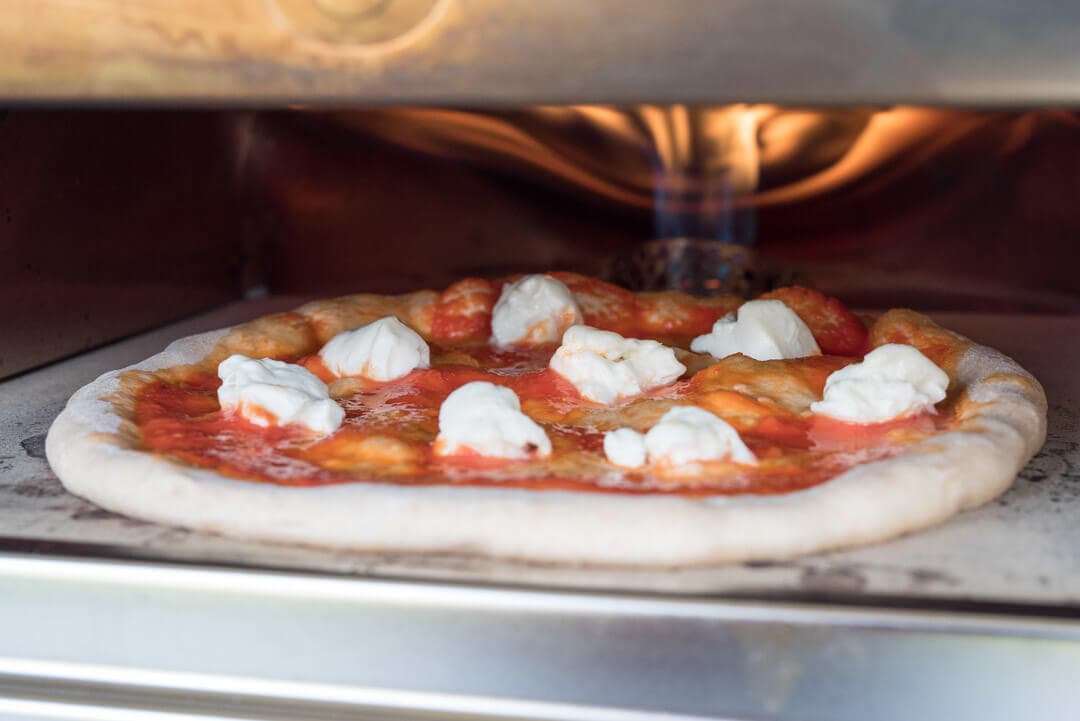A pizza addict. Me. The person writing this post. The person slinging these pies and taking these photographs. I do have a problem, but do I need help? Asking for help is the first step. But I don’t want help, especially with pizza—a more whole wheat sourdough pizza dough—this good. And besides, I have some dough in bulk fermentation right now; I couldn’t possibly let it go to waste. Ok, one more round of pizza, I’ll write this post, then take a good long break, ok? Deal.
The Addiction1 means I’ve made some form of this pizza dough at least once, sometimes twice—or even thrice—a week since midsummer. One might think my desire to eat all this pizza would wane, after all, how much pizza is too much pizza? As it turns out (and as evidenced on Instagram), my upper bound on pizza consumption never really materializes. This is not because of some twisted gluttony I have for pizza, it’s just simply because it’s so good, and so dang easy.

The nighttime rote of mixing my ripe sourdough starter with flour, water, and salt—an all too common scene in my kitchen as the sun descends. The naturally leavened dough is just so easy to put together. It’s so forgiving and flexible. I mix everything in the mixer, do a short bulk fermentation on the counter, then toss it into the fridge. I take it out the next day when convenient. Then, I divide, shape, and proof the dough until it’s time to start the pizzaiolo dance in front of the fire. It’s an easy solution to lunch, dinner, or impromptu gathering at the house—the perfect food.
Thirty percent whole grains in this dough means not only increased nutrition but also significantly more flavor.
In all its perfection and potential for a myriad of toppings beyond what’s conventional, pizza also has another element that is only sometimes experimented with: the dough. I’ve talked about my sourdough pizza dough in the past, and I wanted to take that recipe and modify it to incorporate more whole grains for flavor and nutrition. I started with the modest 10% whole wheat of that recipe and slowly increased it over time. I finally settled at a point where the dough’s flavor was amplified, but the aesthetic of a traditional pizza was not compromised. Thirty percent, that’s a lot of whole grains by most pizza standards—and I know you’ll enjoy the additional flavor the added whole grains bring to each bite.
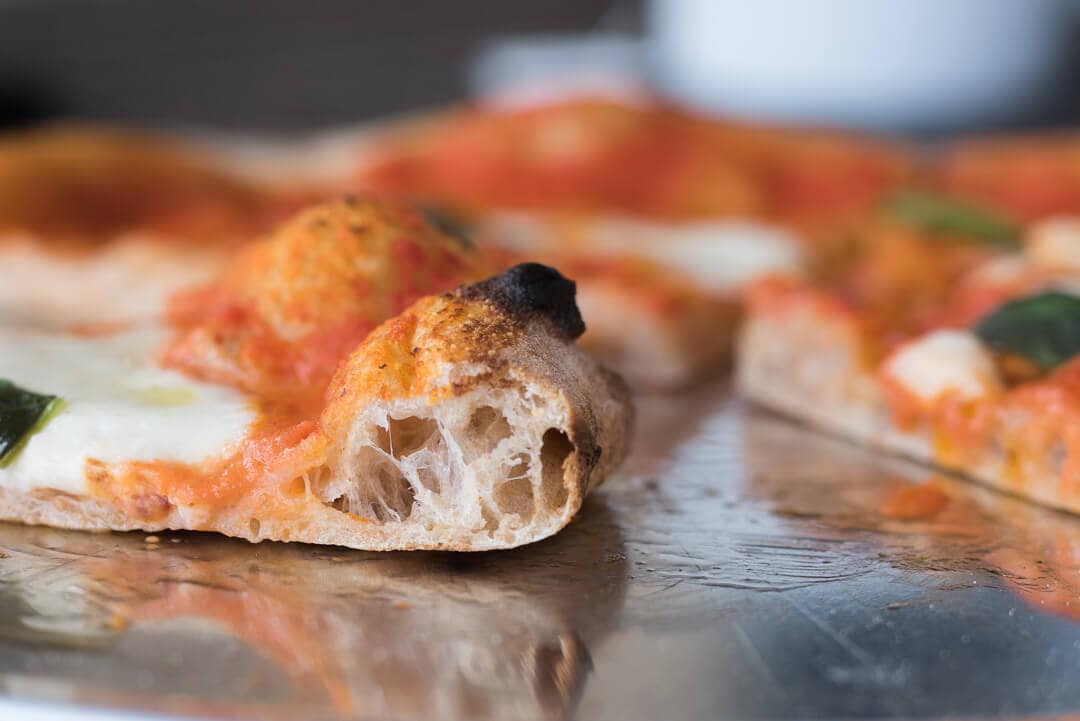
With all these added whole grains I taste a hint more acidity and sourness in the crust, not enough to be overwhelming but enough to add depth and interest. This added complexity plays well with just about every topping selection I could throw on a pizza. More on all of this below, but first let’s talk about ovens.
Oven Selection
Roccbox Gas/Wood Fired Oven
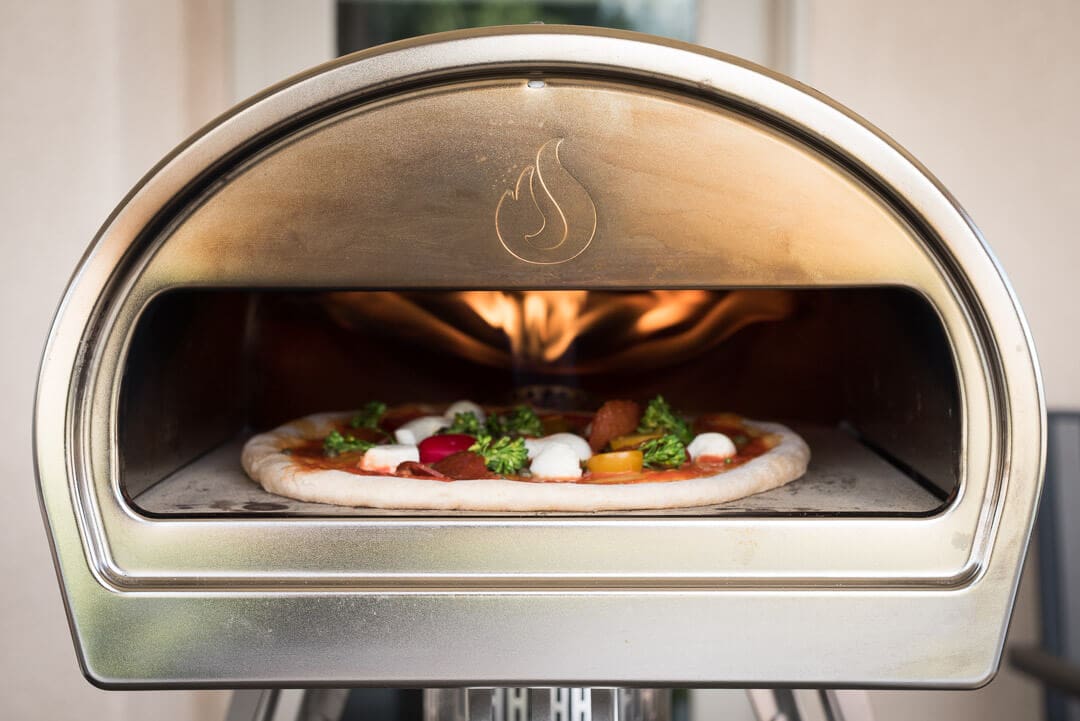
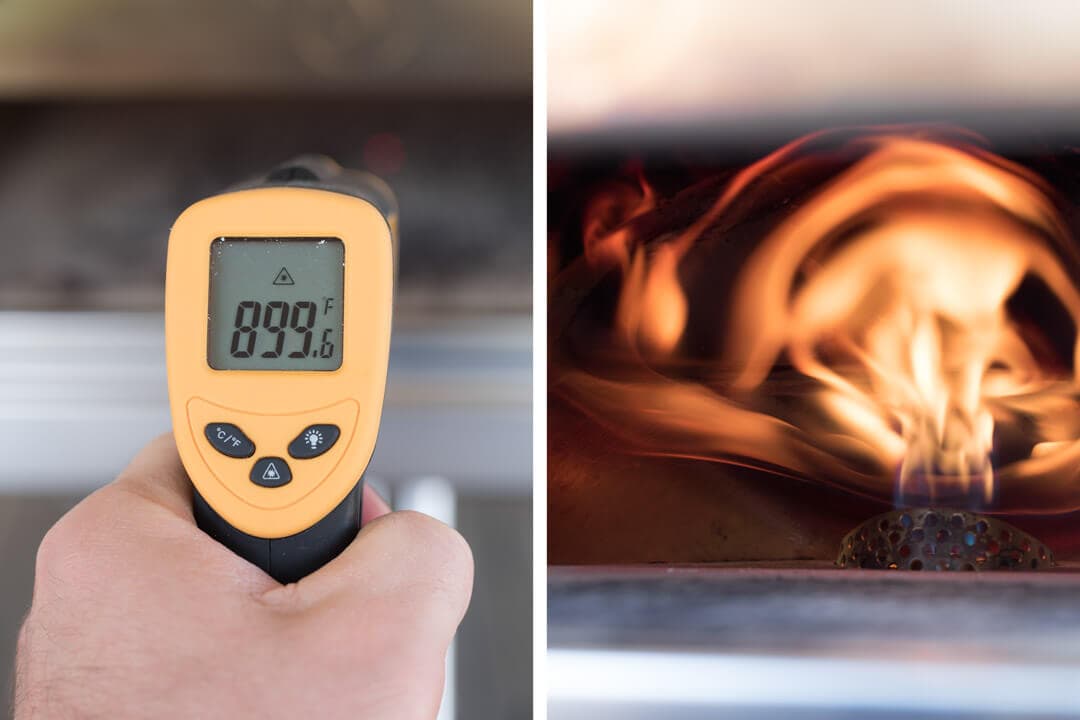
I was lucky enough earlier this year to get in on a preorder for a Roccbox, a small gas (and wood) fired oven that I’ve successfully brought up to temperatures nearing 950°F (510°C)—enough to cook a pizza in minutes. To say I’m in love with this little oven would be an understatement. It’s just a fantastically designed piece of equipment, and oh so convenient. Upon lighting, I can have the oven at max temp in 30-45 minutes and ready for the first pie. I prefer to keep the oven deck at 900°F (482°C), which usually means I turn the oven down midway through my bout of pizza slinging. That’s a novelty: having to turn down the oven because I want it cooler.
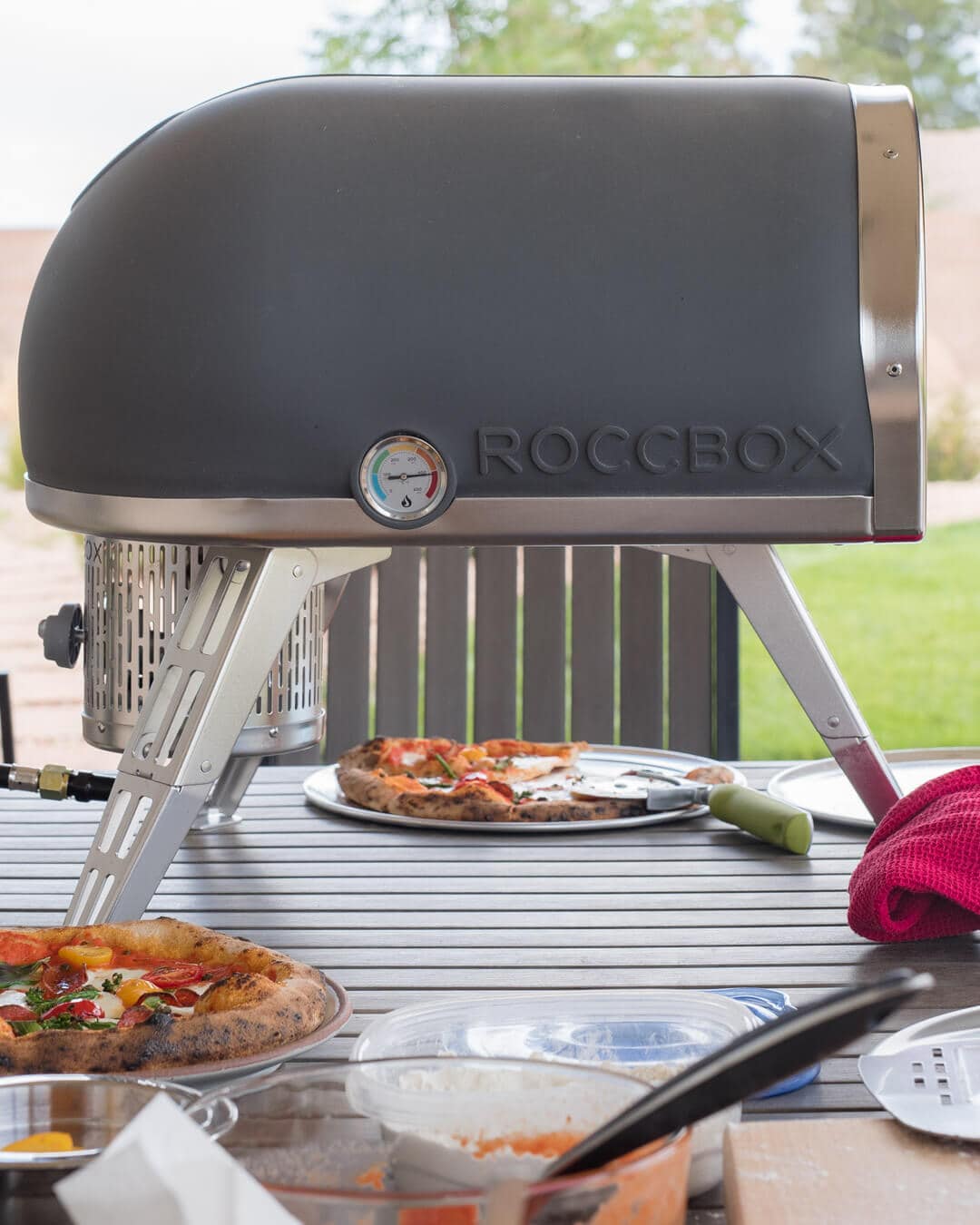
The oven is the perfect apparatus for cooking high fired pizza. I’ve tested making back-to-back pies and the recovery time (the time it takes for the deck to get back up to max temp) is surprisingly fast. The time it takes me to flour, stretch, top and load the next pie is all the oven needs to recover. Another neat feature of the oven is that it comes with two small canisters that swap in and out at the back. One canister provides fuel via propane and the other allows you to load wood pieces into a hopper for burning. I’ve not experimented with the wood hopper yet, the gas option gets so hot and provides such steady heat I’ve had little reason to experiment.
You’ll notice the oven is propped up on 3 extremely sturdy fold-out legs, this means it’s actually quite portable. It is heavy, but the included strap that hugs the deck means I can lug this oven with me to a “guy night” or weekend party at the park. It’s also convenient in that I can set up my pizza making station on my patio—or heck, in my garage in poor weather—in any way I want.
If you’ve been considering a wood-fired oven but haven’t yet made the plunge, I’d highly recommend checking out the Roccbox. I’ve been using it so, so often this summer for recipe testing and the weekend pizza party—it’s just fantastic.
Home Electric/Gas Oven
If you don’t have a Roccbox, know that this dough can easily be adapted for a typical home oven. As I mentioned in my previous sourdough pizza post, due to the longer cook time for a home oven I would increase the hydration of this dough by at least 3-5% (to about 71% hydration) to offset the longer cook time2. The dough will be slightly more tacky to the touch, but if you utilize parchment paper as an aid to load the pizza into your home oven you shouldn’t have any issues.
Flour Selection
I’m a big fan of Central Milling’s Type 00 ‘Normal’ flour as the white flour component of my pizza. If you don’t have 00 flour 3 you can substitute in a general bread flour with lower protein, somewhere around 11-12%. Central Milling Artisan Baker’s Craft, Giusto’s Artisan Bread Flour, or King Arthur All-Purpose will all work well.
For the whole wheat flour component I chose one that’s milled to a very fine granulation (Giusto’s Whole Wheat Fine). Use what you have access to and feel free to experiment. You could substitute all, or part, of the thirty percent with Khorasan, spelt, or another variety of wheat.

A More Whole Wheat Sourdough Pizza Dough Formula
This formula was born from my previous sourdough pizza dough recipe which was intended for a regular home oven. I first modified it to suit a high-fired outdoor oven by significantly reducing the hydration of the dough. This makes for dough that’s much easier to handle, but further, a high hydration dough isn’t necessary when the pizza fully cooks in under 2 minutes. In fact, over time I’ve slowly reduced the hydration with excellent results (my current all-white dough is all the way down to 63% hydration).
Keep in mind that due to the relatively high percentage of whole grain flour in this recipe expect that the dough will ferment at a slightly accelerated pace. Keep an eye on the dough balls after you shape them and if they start displaying signs of extreme puffiness4, place them in the fridge to slow the process until you’re ready to use them.
Vitals
| Total Dough Weight | 2040 grams |
| Hydration | 68% |
| Yield | 8 x 250g dough balls (8 x 12″ pizze) |
Dough Formula
The target final dough temperature (FDT) is 78°F (25°C). See my post on the importance of dough temperature for more information.
| Weight | Ingredient | Baker’s Percentage |
|---|---|---|
| 785g | Type 00 Flour (Central Milling Type 00 Normal) | 70.00% |
| 336g | Whole Wheat Flour, Fine (Giusto’s Organic Whole Wheat, Fine) | 30.00% |
| 762g | Water | 68.00% |
| 22g | Salt | 2.00% |
| 135g | Ripe, 100% hydration liquid starter | 12.00% |
Method
1. Mix – 8:00 p.m.
To the bowl of a stand mixer, add the ripe sourdough starter, salt, flour, and all but 30g of the water (a portion is held back through mixing to ensure the dough is not overhydrated).
Using the dough hook attachment, mix the dough on STIR setting (the first notch) until all the ingredients have come together. Turn the mixer up to speed 2 or 3 and continue to mix the dough for 3 minutes.
Turn off the mixer and assess the dough: does it look (and feel) like it can take more water? It should feel strong and dry, not soupy or weak. Add the water in slowly over the next minute if it looks like it can take it.
Continue mixing for 2-3 more minutes until the dough starts to ball up excessively around the dough hook. We’re not looking for full gluten development at this point, we’ll still perform a few stretch and folds during bulk to finish adding strength.
Transfer the dough to a thick-walled container for bulk fermentation.
2. Warm Bulk Fermentation – 8:05 p.m. to 10:05 p.m.
At 78°F (25°C) ambient temperature bulk fermentation should go for 2 hours.
Perform a total of 3 sets of stretch and folds during bulk, spaced out by 30 minutes. After the last set, let the dough rest until the full 2 hours for bulk.
3. Cold Bulk Fermentation – 10:05 p.m. to 9:00 a.m.
After the full 2 hour warm bulk fermentation dump the dough out to the counter and form it into a large, tight ball. Transfer the dough to a bowl lightly oiled with olive oil and cover. Place the bowl into the fridge until the morning.
4. Divide & Preshape – 9:00 a.m.
Ready one or two large rectangular containers to hold the 8 dough balls by lightly oiling them with olive oil.
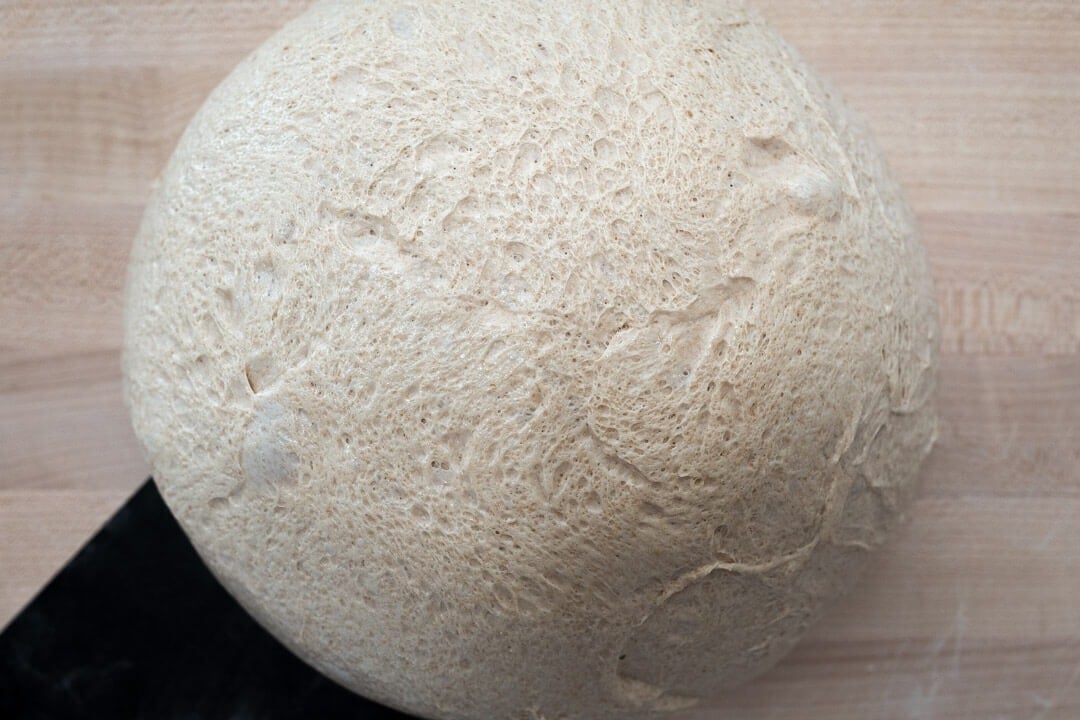
Dump the dough from the bulk container to an un-floured work surface5. Divide the dough into 8 pieces scaled at 250g each (you might have a little leftover).In the above photo, you can see the underside of my dough after I removed it from the fridge and dumped it onto the workbench. Lots of beautiful activity happening there! The cold bulk at about 39°F (3°C) still allows for sufficient fermentation in the dough and you will notice a small rise from when you first placed it into the fridge.
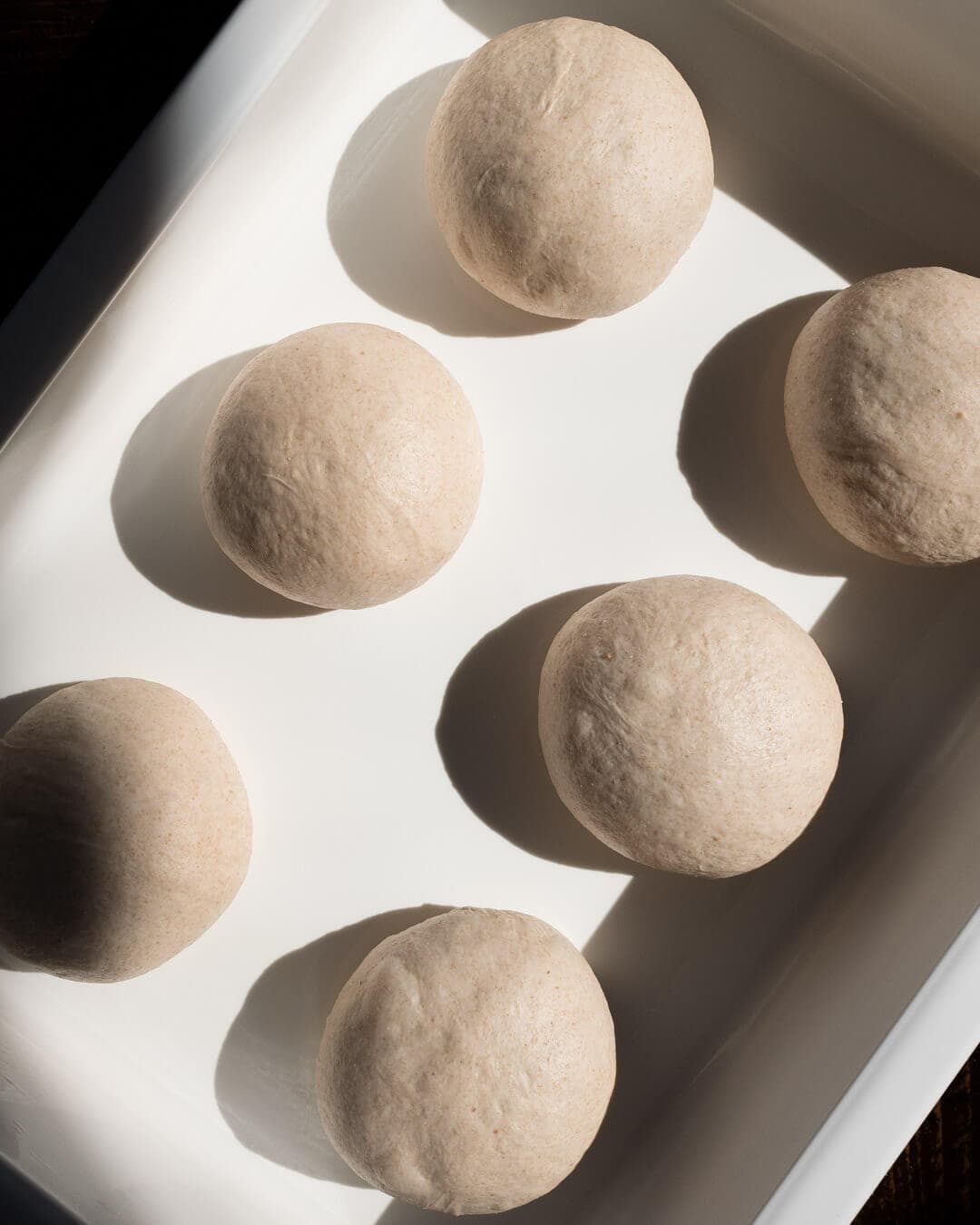
Use your preferred method to form the scaled pieces into very tight balls that have no seam on the bottom (important!). The smooth surface along the outside of the dough sets the stage for shaping a uniformly smooth disc before we top the pie. You can see a video of me balling this dough on Instagram.
When balled, place each into the lightly oiled container with plenty of room to spread as it proofs (see above). Cover the container and leave out at room temperature to proof.
5. Proof – 9:30 a.m. to 12:30 p.m.
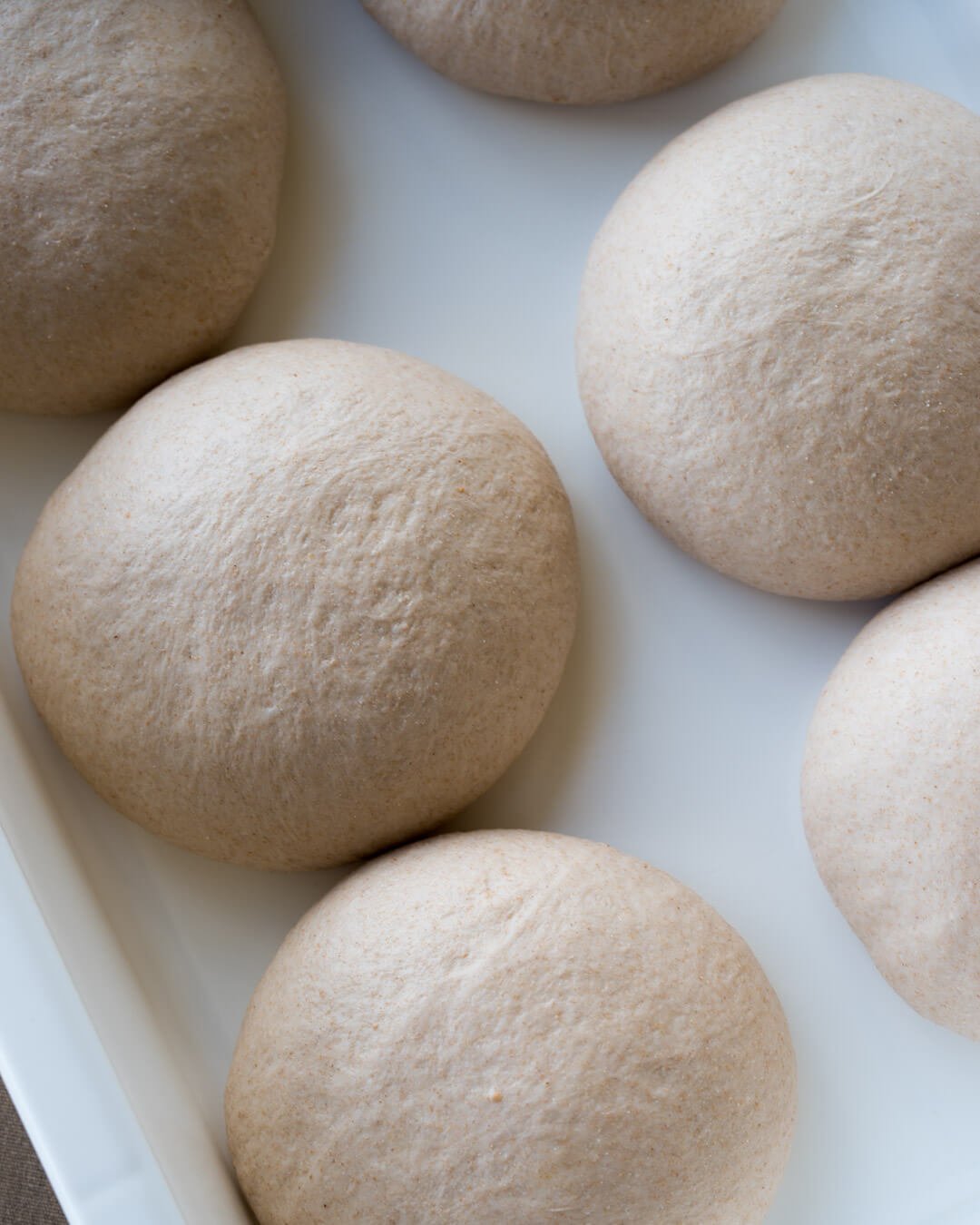
As I mentioned earlier, depending on the ambient temperature in your kitchen this dough can proof rather quickly. Check-in on it from time to time and make sure it’s not gassing up excessively, and if it is, place the containers into the fridge to slow the process. My kitchen was around 78°F (25°C) and these were ready to go after about 3 hours.
In the photo above you can see my fully proofed dough. Compare the way the dough looks at this stage versus the earlier, balled version when it was shaped. You’ll notice significant relaxation and a much more puffy result.
6. Shape, Top, and Cook – 12:30 p.m. onwards
Preheat your oven and ready your pizza station. If using a home electric oven, see my previous post on sourdough pizza for tips on cooking these. If using a Roccbox, preheat the oven 45 minutes before you plan to make your first pie.
Flour your workbench and carefully pull a dough ball out of the oiled container and flip it over onto the bench. Flour the top of the ball (which is actually the bottom) and begin pressing it out while keeping it in a circle. After a few presses, flip the dough ball so the smooth surface is now facing up. Now continue to press out the ball, turning it a few times to keep it symmetrical.
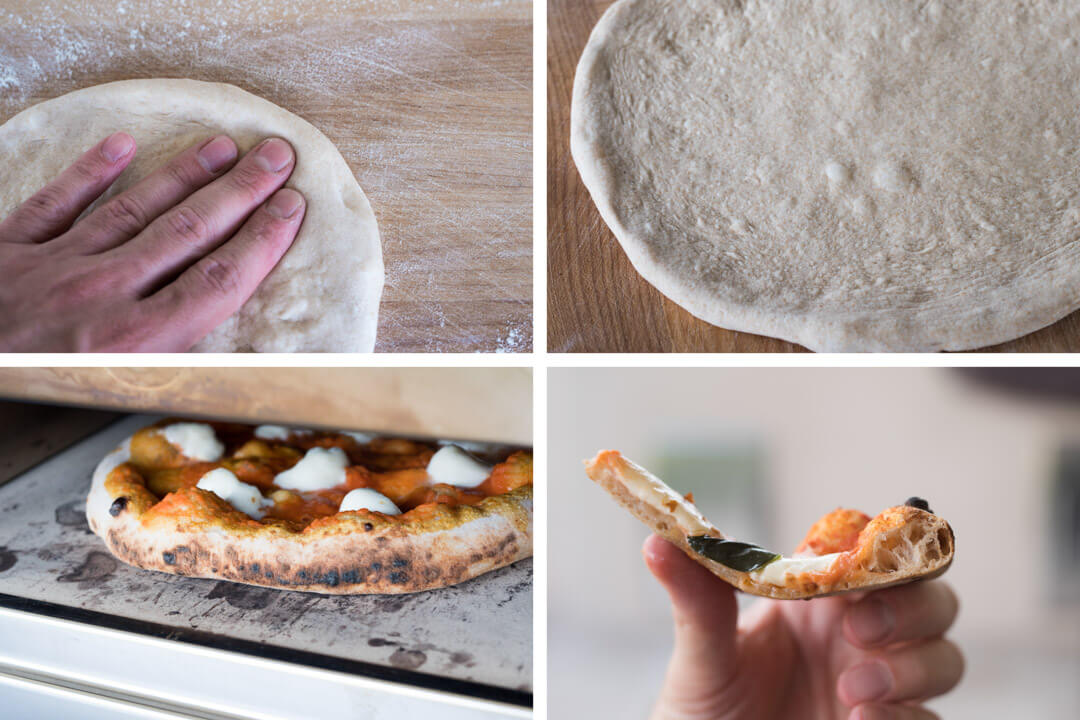
When pressing out I like to keep a small rim around the outside (see top-left, above). This small rim will eventually form the outside crust (cornicione) and I am deliberate to not stretch this area excessively. Once you have uniformly spread the dough, pick it up and drape it over top of the back of your knuckles and hands. Imagine holding two clinched fists up in the air (like a boxer) with the dough draped over them. Then, gently separate your fists as you stretch the dough out further. Rotate the dough around as you do this stretching until the dough is evenly enlarged.
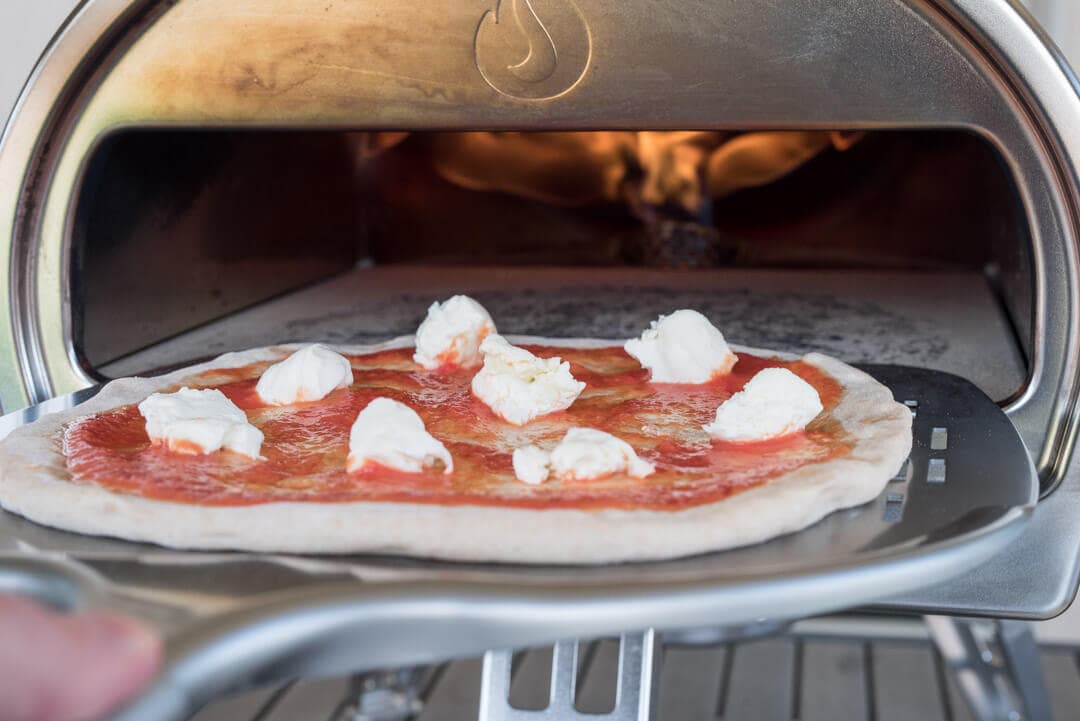
Using a shallow ladle, spread prepared tomato sauce on the pie and place whatever toppings you desire. Cook and enjoy.
See my guide to stretching and shaping pizza dough for more help →
Conclusion
The whole wheat flour used in this formula brings with it a new depth of flavor. Through proper fermentation, this dough has subtle acidity and complexity that’s not overpowering, but rather, a beautiful complement to any toppings littered on the surface. Additionally, the crust takes on a new texture versus using all white flour. It’s still very thin, light, and crunchy, but at the same time, it has more substance and depth. This is a nice change from soft, pliable pizza dough you usually get when a pizza is made with a high fired oven (neo-Neopolitan style, perhaps).

Expanding our pizza-making repertoire with various dough formulas seems a natural progression, and this whole wheat sourdough pizza dough is no different. There’s always going to be a place for a 100% type 00 dough, but it’s fun to explore. I started with my previous sourdough pizza dough recipe and by upping the whole grains a whole new pizza was the result. You’ll be shocked to discover how much of a flavor difference there is with a change to the whole wheat amount in this dough.
Pizza is the ultimate common denominator when deciding what to eat for a meal. When searching the depths for cravings, it sits, waiting patiently. It knows you know. It knows you’ll find it. And then, as if by some artificial happenstance, you proclaim to yourself: “Oh hey, I know! What about pizza?” The truth is, pizza, in its fundamentally simplistic nature, is the food everyone can agree on. It’s comfort food that morphs and accommodates any and (almost) all toppings. It’s the perfect food.
Ok, as I promised in the beginning, this will be the last pizza post for a little while… Just don’t keep tabs on me via Instagram. No, don’t do that.
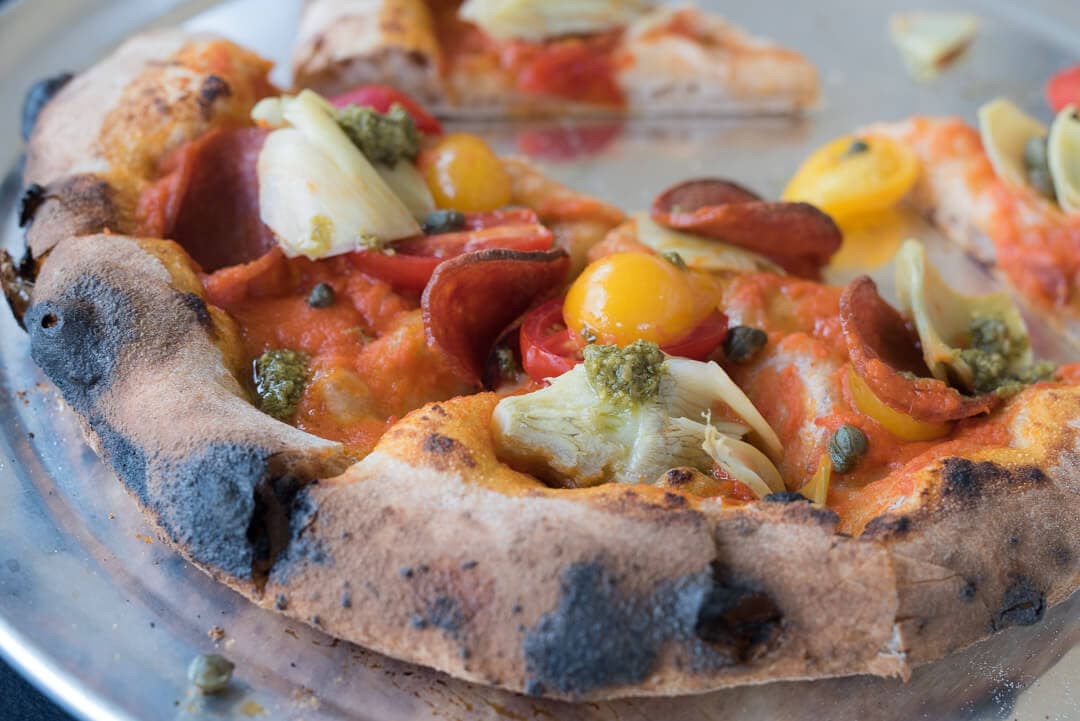
What’s Next?
If you’re interested in a different take on pizza, check out my sourdough pizza al taglio recipe, which is pizza cooked in a sheet pan—rectangular is fun (and delicious)! Or, if you want to try my go-to and very flexible dough for a high-heat oven, check out my wood-fired sourdough pizza dough recipe.
Or, see my sourdough pizza guide page for more shaping and stretching tips plus a round-up of my favorite pizza tools and methods for adjusting flavor and more.
Buon appetito!
If you use this recipe, tag @maurizio on Instagram so I can take a look!
Thanks so much to Gozney/Roccbox for sponsoring this post. As always, the opinions and content here are my own.
I talk about it like it’s sitting right here next to me as I write this.↩
The longer it takes the pizza to cook the more moisture will be cooked out of the dough.↩
That is, flour with a low extraction percentage and a very fine granulation.↩
So, so technical.↩
Bench flour isn’t really necessary to form these balls as the dough will be cold and very easy to handle.↩


